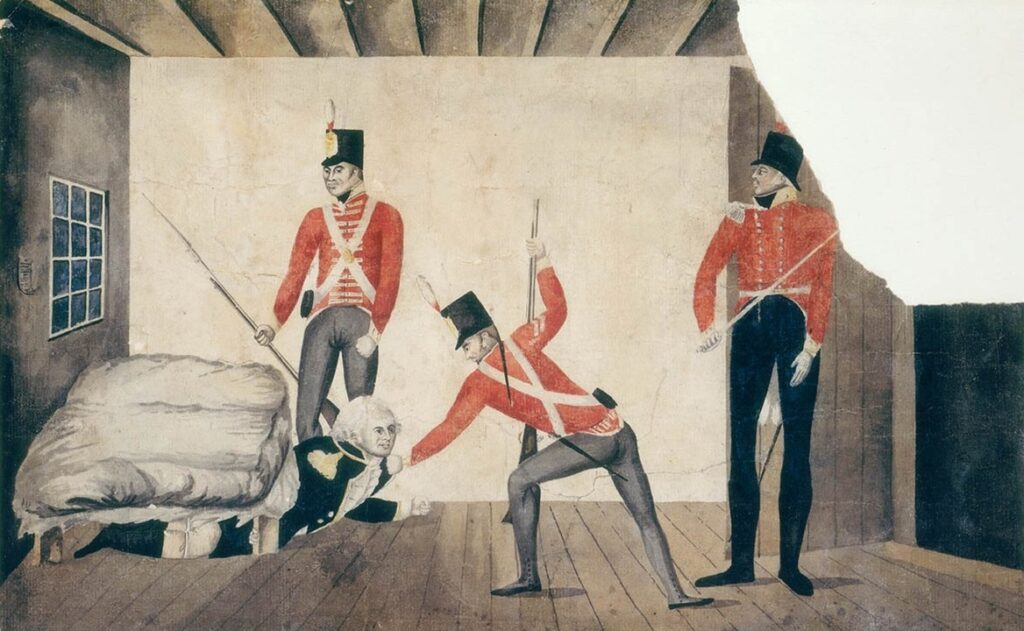The Rum Rebellion & The Silly Old Man

Rear-Admiral William Bligh, by Alexander Huey.
National Library of Australia, 11230917
Australia Day 1808
On the evening of Sunday, 24 January 1808, the officers of the New South Wales Corps held a mess dinner at the Sydney barracks to plot the downfall of Governor Bligh. The evening concluded with the officers dancing drunkenly together to the music of the regimental fife band. It was common practice for men to dance together – most likely they danced country dances, reels, or hornpipes.
Two days later, the band of the New South Wales Corps with colours flying and fifes and drums playing marched to Government House to the tune of The British Grenadiers. To many in the regiment, Governor Bligh was seen as a bad-tempered tyrant, though this was mainly due to his orders to regulate the rum trade which was controlled by the Corps’ officers. Bligh was deposed on 26 January, a day some of the most passionate advocates dubbed the “Glorious 26th”.

Propaganda cartoon of Bligh’s arrest in Sydney in 1808, portraying him as a coward. State Library of New South Wales, Sydney.
As the band marched away down Bridge Street they struck up the tune Britons Weep and in the days that followed “they indulged in a frenzy of jubilation. Muskets and cannon volleyed in salute, sheep were roasted, liquor was distributed, bonfires lit the night in Sydney and Parramatta, and people signed their names to petitions that rejoiced in their deliverance. Bligh was burnt in effigy, ridiculed in a popular song called ‘The Silly Old Man’ and humiliated at taverns by signs that proclaimed The ever memorable 26th of January 1808’. (Ritchie, 1999, p. 113)
Tavern culture was reported in the colony as early as 1789 and by 1808 was flourishing – dancing was one of the main entertainments (Jordan, 2012). The dance The Silly Old Man was published in Walsh’s Third Book of the Compleat Country Dancing-Master (c. 1735) and Caledonian Country Dances (c.1745). It also appeared in Johnson’s Choice Collection (1740) and Caledonian Country Dances (1750).
Now available on our CD
Country dance: Duple minor longways.
(adapted from triple minor)
| A1 | 1-3 | 1st man and 2nd lady (1st corners) clap hands (own, right, own, left) and turn single. |
| 4-6 | 1st corners change places by the right shoulder, 2nd corners change places by the left shoulder. | |
| A2 | 1-3 | 1st lady and 2nd man (2nd corners) clap hands (own, right, own, left) and turn single. |
| 4-6 | 2nd corners change places by the right shoulder, 1st corners change places by the left shoulder. | |
| B1 | 1-6 | 1st couple cross over, cast into 2nd place [2nd couple move up] and dance ½ a figure of eight around the 2nd couple. |
| B2 | 1-6 | 1st couple dance down between the couple below (borrowed from the set below), cast up into 2nd place, dance up between the 2nd couple, cast one place. |

Caledonian Country Dances, Being a collection of all the celebrated Scotch country dances now in vogue … 3.d edition (London; J. Walsh, [n.d.]), 76
http://digital.nls.uk/special-collections-of-printed-music/pageturner.cfm?id=94558320
Sources
Dando-Collins, S. (2007). Captain Bligh’s other mutiny. Sydney: Random House.
Jordan, R. (2012). Music and civil society in New South Wales, 1788-1809. Journal of the Royal Australian Historical Society, 98(2), 193.
Keller, R. M. (2006). Dance Figures Index: English Country Dances, 1650-1833. from The Colonial Music Institute https://www.cdss.org/elibrary/DFIE/Index.htm
Paterson, G. (1811). The history of New South Wales. Newcastle-on-Tyne: Mackenzie and Dent.
Ritchie, J. (1999). The Wentworths. Father and Son.Carlton, Vic: Melbourne University Press.
Shaw, A. G. L. (1966). Bligh, William (1754–1817).
http://adb.anu.edu.au/biography/bligh-william-1797
Skinner, G. (2019). Australharmony: An online resource toward the history of music in colonial and early Federation Australia. Retrieved 20 November 2019 from https://sydney.edu.au/paradisec/australharmony/chronicle1801-1810.php#1808-01-28-silly-old-man
______________________________________________________________
The information on this website www.historicaldance.au may be copied for personal use only, and must be acknowledged as from this website. It may not be reproduced for publication without prior permission from Heather Clarke.


